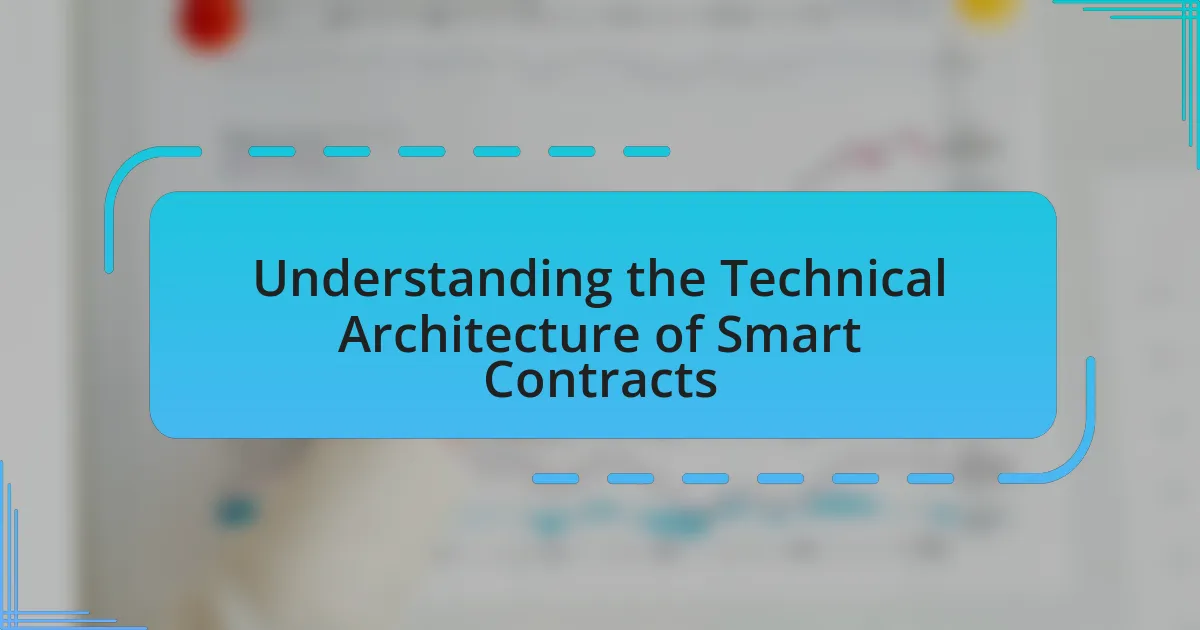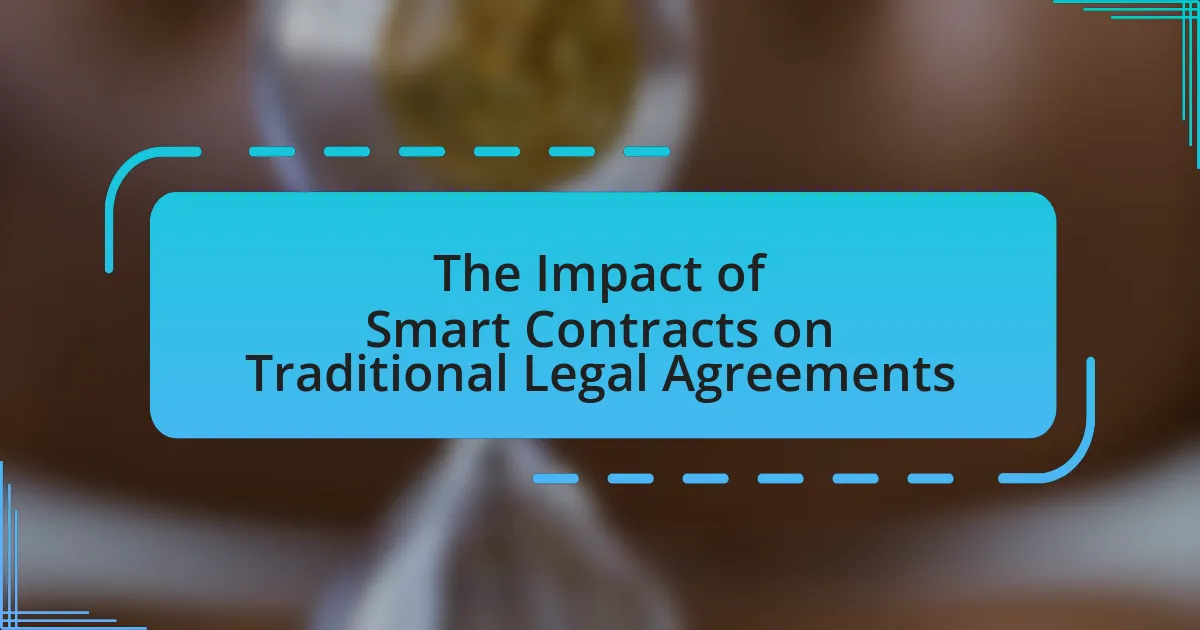Smart contracts are self-executing agreements coded on blockchain technology, playing a crucial role in decentralized finance (DeFi) by automating transactions and eliminating intermediaries. This article explores the functionality of smart contracts within DeFi ecosystems, detailing their programming languages, security measures, and the key features that enhance trust and efficiency. It also addresses the challenges faced by smart contracts, including security vulnerabilities and regulatory concerns, while highlighting their impact on various DeFi applications such as lending, borrowing, and decentralized exchanges. Additionally, the article discusses future trends, best practices for developers, and measures users can take to ensure safety when interacting with smart contracts.
What are Smart Contracts in the Context of Decentralized Finance (DeFi)?
Smart contracts in the context of decentralized finance (DeFi) are self-executing contracts with the terms of the agreement directly written into code, enabling automated transactions without intermediaries. These contracts operate on blockchain technology, ensuring transparency, security, and immutability, which are essential for DeFi applications. For instance, Ethereum, a leading blockchain platform, supports smart contracts that facilitate various financial services such as lending, borrowing, and trading, thereby eliminating the need for traditional financial institutions. The use of smart contracts in DeFi has led to a significant increase in decentralized applications, with the total value locked in DeFi protocols exceeding $80 billion as of 2021, demonstrating their pivotal role in transforming financial services.
How do Smart Contracts function within DeFi ecosystems?
Smart contracts function as self-executing agreements with the terms directly written into code within DeFi ecosystems. They automate processes such as lending, borrowing, and trading by executing transactions when predefined conditions are met, eliminating the need for intermediaries. For instance, in a lending platform, a smart contract can automatically transfer collateral and funds between parties based on the agreed terms, ensuring transparency and security. This functionality is supported by blockchain technology, which provides an immutable and decentralized ledger, enhancing trust among users.
What programming languages are commonly used to create Smart Contracts?
The programming languages commonly used to create Smart Contracts include Solidity, Vyper, and Rust. Solidity is the most widely used language for Ethereum-based Smart Contracts, designed specifically for the Ethereum Virtual Machine (EVM). Vyper is another language for Ethereum that emphasizes security and simplicity, making it suitable for Smart Contracts that require a high level of trust. Rust is utilized in the development of Smart Contracts on platforms like Polkadot and Solana, known for its performance and safety features. These languages are integral to the functionality and security of Smart Contracts in decentralized finance applications.
How do Smart Contracts ensure trust and security in DeFi transactions?
Smart contracts ensure trust and security in DeFi transactions by automating and enforcing agreements through code, eliminating the need for intermediaries. These self-executing contracts operate on blockchain technology, which provides transparency and immutability, ensuring that once a contract is deployed, it cannot be altered or tampered with. This characteristic significantly reduces the risk of fraud and enhances trust among participants. Additionally, smart contracts utilize cryptographic techniques to secure transaction data, making it difficult for unauthorized parties to access or manipulate sensitive information. The combination of automation, transparency, and cryptographic security creates a reliable environment for conducting financial transactions in decentralized finance.
What are the key features of Smart Contracts in DeFi?
Smart contracts in DeFi are self-executing contracts with the terms of the agreement directly written into code. Key features include automation, which eliminates the need for intermediaries, thereby reducing costs and increasing efficiency; transparency, as all transactions are recorded on a public blockchain, allowing for verification by any participant; and security, since smart contracts utilize cryptographic techniques to ensure data integrity and prevent tampering. Additionally, programmability allows developers to create complex financial instruments and protocols, enabling innovative financial services. These features collectively enhance trust and accessibility in decentralized finance.
How do Smart Contracts automate processes in DeFi applications?
Smart contracts automate processes in DeFi applications by executing predefined conditions without the need for intermediaries. These self-executing contracts are coded on blockchain platforms, enabling automatic transactions and operations when specific criteria are met. For instance, in lending protocols, smart contracts can automatically facilitate the transfer of collateral and funds based on the agreed terms, ensuring transparency and reducing the risk of default. This automation enhances efficiency and trust in financial transactions, as evidenced by the rapid growth of DeFi platforms, which collectively locked over $80 billion in assets by mid-2021, demonstrating the effectiveness of smart contracts in streamlining decentralized financial services.
What role do Smart Contracts play in reducing transaction costs?
Smart contracts significantly reduce transaction costs by automating and streamlining processes that traditionally require intermediaries. By executing predefined conditions on a blockchain, smart contracts eliminate the need for third-party involvement, which often incurs fees and delays. For instance, a study by the World Economic Forum estimates that smart contracts could save businesses up to $3 trillion annually by minimizing administrative costs and enhancing efficiency in transactions.
What challenges do Smart Contracts face in DeFi?
Smart contracts in DeFi face several challenges, including security vulnerabilities, scalability issues, and regulatory uncertainty. Security vulnerabilities arise from coding errors and exploits, as evidenced by incidents like the DAO hack in 2016, which resulted in a loss of $60 million. Scalability issues are significant as blockchain networks often struggle to handle high transaction volumes, leading to slow processing times and increased fees, as seen during the Ethereum network congestion in 2021. Regulatory uncertainty complicates the deployment of smart contracts, as differing regulations across jurisdictions can hinder their adoption and integration into traditional financial systems.
How do vulnerabilities in Smart Contracts impact DeFi platforms?
Vulnerabilities in smart contracts significantly impact DeFi platforms by exposing them to risks such as financial loss, exploitation, and loss of user trust. When a smart contract contains flaws, malicious actors can exploit these weaknesses to manipulate transactions, drain funds, or execute unauthorized actions. For instance, the infamous DAO hack in 2016 resulted in the loss of $60 million worth of Ether due to a vulnerability in the smart contract code. Such incidents not only lead to immediate financial repercussions but also diminish user confidence in the security of DeFi platforms, potentially stunting their growth and adoption.
What measures can be taken to enhance the security of Smart Contracts?
To enhance the security of smart contracts, developers can implement rigorous testing and auditing processes. Conducting comprehensive unit tests, integration tests, and formal verification can identify vulnerabilities before deployment. Additionally, utilizing established security frameworks and best practices, such as the OWASP Top Ten for smart contracts, helps mitigate common risks. Engaging third-party security auditors to review the code can provide an external perspective on potential weaknesses. Furthermore, employing upgradeable contract patterns allows for the correction of vulnerabilities post-deployment, ensuring ongoing security. These measures are supported by industry standards and practices that have proven effective in reducing incidents of exploits and hacks in smart contracts.
How do Smart Contracts facilitate various DeFi applications?
Smart contracts facilitate various DeFi applications by automating and enforcing agreements without intermediaries. They execute predefined conditions, enabling functionalities such as lending, borrowing, and trading on decentralized platforms. For instance, in lending protocols, smart contracts automatically manage collateral and interest rates, ensuring transparency and security. According to a report by the World Economic Forum, smart contracts can reduce transaction costs by up to 90% in financial services, demonstrating their efficiency in DeFi ecosystems.
What types of DeFi applications rely on Smart Contracts?
Decentralized Finance (DeFi) applications that rely on smart contracts include decentralized exchanges (DEXs), lending platforms, yield farming protocols, stablecoins, and insurance platforms. These applications utilize smart contracts to automate transactions, enforce agreements, and ensure transparency without intermediaries. For instance, decentralized exchanges like Uniswap use smart contracts to facilitate peer-to-peer trading of cryptocurrencies, while lending platforms such as Aave employ smart contracts to manage collateral and loan agreements automatically. This reliance on smart contracts enhances security and efficiency in financial transactions within the DeFi ecosystem.
How do Smart Contracts enable decentralized lending and borrowing?
Smart contracts enable decentralized lending and borrowing by automating and enforcing the terms of financial agreements without intermediaries. They execute transactions based on predefined conditions coded into the blockchain, ensuring transparency and security. For instance, platforms like Aave and Compound utilize smart contracts to facilitate peer-to-peer lending, allowing users to lend their assets and earn interest while borrowers can access funds without traditional banks. This process is governed by algorithms that determine interest rates and collateral requirements, reducing the risk of default and enhancing efficiency. The use of smart contracts in these platforms has led to a significant increase in decentralized finance activity, with billions of dollars locked in various lending protocols, demonstrating their effectiveness in transforming traditional financial systems.
What is the role of Smart Contracts in decentralized exchanges (DEXs)?
Smart contracts are essential in decentralized exchanges (DEXs) as they automate and enforce the trading process without intermediaries. These self-executing contracts facilitate peer-to-peer transactions by executing trades based on predefined conditions coded within the blockchain. For instance, when a user places an order, the smart contract verifies the transaction details, ensuring that both parties fulfill their obligations before executing the trade. This mechanism enhances security and trust, as the code is immutable and transparent, reducing the risk of fraud. Additionally, smart contracts enable features like liquidity pools and automated market-making, which are fundamental to the functionality of DEXs, allowing users to trade assets directly from their wallets while maintaining control over their funds.
How do Smart Contracts contribute to liquidity provision in DeFi?
Smart contracts facilitate liquidity provision in DeFi by automating transactions and enabling decentralized exchanges to operate without intermediaries. They execute predefined conditions, allowing users to provide liquidity by depositing assets into liquidity pools, which are then used for trading. This automation reduces the need for manual intervention, increases efficiency, and enhances trust among participants. According to a report by DeFi Pulse, as of October 2023, over $80 billion is locked in DeFi protocols, demonstrating the significant role smart contracts play in attracting liquidity.
What mechanisms do Smart Contracts use to manage liquidity pools?
Smart contracts manage liquidity pools through automated protocols that facilitate the creation, maintenance, and operation of these pools. They utilize mechanisms such as liquidity provision incentives, automated market making, and dynamic pricing algorithms to ensure efficient trading and liquidity availability. For instance, liquidity providers earn fees based on the volume of trades executed within the pool, which encourages them to supply assets. Additionally, automated market makers (AMMs) adjust asset prices based on supply and demand, ensuring that liquidity is always available for traders. These mechanisms are foundational to decentralized finance, as they eliminate the need for intermediaries and enhance transaction efficiency.
How do Smart Contracts incentivize liquidity providers?
Smart contracts incentivize liquidity providers by automating reward distribution and ensuring transparent, trustless transactions. They facilitate liquidity provision by allowing users to deposit assets into liquidity pools, where they earn fees from trades executed within the pool. For instance, in decentralized exchanges like Uniswap, liquidity providers receive a percentage of the trading fees proportional to their contribution to the pool. This model encourages participation by offering a direct financial incentive, as liquidity providers can earn passive income while maintaining control over their assets. The efficiency and reliability of smart contracts eliminate the need for intermediaries, further enhancing the appeal for liquidity providers in decentralized finance.
What impact do Smart Contracts have on user experience in DeFi?
Smart contracts significantly enhance user experience in DeFi by automating transactions and ensuring trustless interactions. This automation reduces the need for intermediaries, streamlining processes such as lending, borrowing, and trading. For instance, users can execute complex financial agreements without relying on third parties, which minimizes delays and lowers costs. Additionally, smart contracts operate on transparent blockchain networks, allowing users to verify the terms and conditions independently, thereby increasing confidence in the system. According to a report by the World Economic Forum, smart contracts can potentially reduce transaction costs by up to 90%, demonstrating their efficiency and positive impact on user experience in decentralized finance.
How do Smart Contracts simplify user interactions with DeFi platforms?
Smart contracts simplify user interactions with DeFi platforms by automating processes and eliminating intermediaries. This automation allows users to execute transactions, such as lending or trading, directly on the blockchain without the need for a centralized authority. For instance, smart contracts can automatically enforce the terms of a loan agreement, ensuring that funds are released only when specific conditions are met. This reduces the risk of human error and enhances security, as the code is immutable and transparent. Additionally, the use of smart contracts increases efficiency by enabling faster transactions, as they operate on predefined rules without delays associated with traditional financial systems.
What are the potential risks users face when engaging with Smart Contracts?
Users face several potential risks when engaging with smart contracts, including coding errors, security vulnerabilities, and lack of regulatory oversight. Coding errors can lead to unintended consequences, as seen in the DAO hack of 2016, where a vulnerability in the smart contract code resulted in the loss of $60 million worth of Ether. Security vulnerabilities, such as reentrancy attacks, can also compromise funds, highlighting the importance of thorough code audits. Additionally, the decentralized nature of smart contracts often means that users have limited recourse in the event of a dispute or failure, as there is typically no central authority to address issues.
What are the future trends for Smart Contracts in DeFi?
Future trends for smart contracts in DeFi include increased interoperability, enhanced security measures, and the integration of artificial intelligence. Interoperability will allow different blockchain networks to communicate seamlessly, facilitating cross-platform DeFi applications. Enhanced security measures, such as formal verification and auditing, will address vulnerabilities and build user trust, as evidenced by the rise in smart contract hacks, which reached over $1 billion in 2021. The integration of artificial intelligence will enable more sophisticated automated decision-making processes, improving efficiency and user experience in DeFi transactions.
How is the evolution of blockchain technology influencing Smart Contracts?
The evolution of blockchain technology is significantly enhancing the functionality and reliability of Smart Contracts. As blockchain technology advances, it provides improved scalability, security, and interoperability, which directly benefits Smart Contracts by enabling them to execute more complex and varied transactions efficiently. For instance, the introduction of layer-2 solutions, such as the Lightning Network for Bitcoin and various scaling solutions for Ethereum, allows Smart Contracts to process a higher volume of transactions at lower costs, thereby increasing their practical applications in decentralized finance (DeFi). Additionally, advancements in consensus mechanisms, such as proof-of-stake, enhance the security and energy efficiency of blockchain networks, making Smart Contracts more trustworthy and appealing for users.
What advancements are being made in Smart Contract programming languages?
Advancements in Smart Contract programming languages include the development of more secure and efficient languages such as Solidity, Vyper, and Rust. Solidity has introduced features like custom error messages and improved gas efficiency, enhancing developer experience and reducing transaction costs. Vyper focuses on security and simplicity, making it easier to audit smart contracts, while Rust, used in projects like Polkadot and Solana, offers memory safety and concurrency, which are critical for high-performance decentralized applications. These advancements are supported by growing community resources, improved tooling, and enhanced documentation, which collectively contribute to the robustness and reliability of smart contracts in the DeFi ecosystem.
How might regulatory changes affect the use of Smart Contracts in DeFi?
Regulatory changes can significantly impact the use of smart contracts in decentralized finance (DeFi) by imposing compliance requirements that may restrict their functionality. For instance, if regulators mandate Know Your Customer (KYC) and Anti-Money Laundering (AML) protocols, smart contracts would need to integrate these processes, potentially reducing their decentralized nature and efficiency. Historical examples include the European Union’s Markets in Crypto-Assets (MiCA) regulation, which aims to create a comprehensive regulatory framework for crypto assets, influencing how smart contracts are developed and utilized in DeFi platforms. Such regulations could lead to increased operational costs and complexity, ultimately affecting the innovation and adoption of smart contracts in the DeFi ecosystem.
What best practices should developers follow when creating Smart Contracts?
Developers should follow several best practices when creating Smart Contracts to ensure security, efficiency, and reliability. First, they must conduct thorough testing and audits to identify vulnerabilities, as evidenced by the high-profile hacks in the DeFi space, such as the $60 million hack of the bZx protocol in 2020, which highlighted the importance of security measures. Second, developers should use established frameworks and libraries, like OpenZeppelin, which provide vetted code to minimize risks. Third, they should implement proper access controls to prevent unauthorized actions, as seen in the DAO hack of 2016, where inadequate permissions led to significant losses. Additionally, developers should document their code clearly to facilitate understanding and maintenance, which is crucial for long-term project sustainability. Finally, they should keep contracts upgradable to adapt to changing requirements and fix potential issues, as demonstrated by the evolving nature of DeFi protocols.
How can developers ensure the security and reliability of Smart Contracts?
Developers can ensure the security and reliability of Smart Contracts by implementing rigorous testing, code audits, and utilizing formal verification methods. Rigorous testing involves using unit tests and integration tests to identify vulnerabilities before deployment. Code audits, conducted by independent security experts, help uncover potential flaws and ensure adherence to best practices. Formal verification applies mathematical methods to prove the correctness of the contract’s logic, significantly reducing the risk of errors. According to a study by ConsenSys, 70% of Smart Contracts contain vulnerabilities, highlighting the importance of these practices in enhancing security and reliability.
What tools and frameworks are available for Smart Contract development?
Tools and frameworks available for Smart Contract development include Solidity, Truffle, Hardhat, and Remix. Solidity is the primary programming language for writing smart contracts on the Ethereum blockchain, while Truffle provides a development environment and testing framework. Hardhat offers a flexible framework for Ethereum development, including debugging and testing capabilities. Remix is an online IDE that allows developers to write, test, and deploy smart contracts directly in the browser. These tools are widely used in the decentralized finance (DeFi) ecosystem to facilitate the creation and management of smart contracts.
What common pitfalls should users avoid when interacting with Smart Contracts?
Users should avoid several common pitfalls when interacting with Smart Contracts, including inadequate understanding of contract terms, reliance on unverified code, and failure to consider security vulnerabilities. Inadequate understanding can lead to misinterpretation of the contract’s functionality and risks, as many users may not fully grasp the implications of the terms they agree to. Reliance on unverified code is risky because Smart Contracts can contain bugs or malicious code that could result in financial loss; for instance, the DAO hack in 2016 exploited vulnerabilities in Smart Contracts, leading to a loss of $60 million. Additionally, users often overlook security vulnerabilities such as reentrancy attacks, which can compromise the integrity of the contract and lead to unauthorized fund withdrawals.
How can users protect themselves from Smart Contract vulnerabilities?
Users can protect themselves from Smart Contract vulnerabilities by conducting thorough audits and using reputable platforms. Engaging with smart contracts that have undergone independent security audits reduces the risk of exploits, as these audits identify potential vulnerabilities before deployment. Additionally, users should only interact with well-established projects that have a proven track record and community trust, as these are less likely to have critical flaws. According to a report by ConsenSys, over 70% of smart contract vulnerabilities can be mitigated through proper auditing and testing practices, highlighting the importance of these measures in ensuring user safety in decentralized finance.
What steps should users take to verify the legitimacy of Smart Contracts?
Users should take the following steps to verify the legitimacy of Smart Contracts: first, they should review the contract’s code to ensure it is open-source and accessible for scrutiny. This transparency allows users to check for vulnerabilities or malicious code. Second, users should check for audits conducted by reputable third-party firms, as these audits provide an assessment of the contract’s security and functionality. Third, users should examine the project’s team and their track record in the blockchain space, as experienced developers are more likely to produce reliable contracts. Fourth, users should look for community feedback and discussions on platforms like GitHub or forums, as active engagement can indicate a trustworthy project. Lastly, users should verify the contract’s deployment on the blockchain by checking the transaction history and ensuring it matches the project’s claims. These steps collectively help users assess the credibility and safety of Smart Contracts in the DeFi ecosystem.




